Car detailing is a very different process compared to simply washing your car. This ultimate guide will answer all of your detailing questions and also show you how to detail a car like a pro.
With our Fast Car event series in full flow, we’ve put together this complete guide to detailing your car to make sure that your car is not only being shown in its best light, but its bodywork is suitably protected as well. After all, detailing isn’t just about making a car clean, it’s also about ensuring its protected from the weather, road grime and other nasty bits of dirt then eventually lead to paintwork damage and in a worst case scenario, rust! Below, we’ll go through what car detailing is, the steps involved if you want to get the job done correctly both inside and outside, as well as comparing your detail at home to automated car washes and hand wash services as well as professional detailers. Finally, we’ll cover off some all important frequently asked questions when it comes to cleaning your car.
What is car detailing and why is it important?
Car detailing is the art of cleaning a car to a point at which it looks almost-new. It’s easy to give your car a quick wash and vacuum, but detailing transforms your car from looking OK to virtually new. It’s all about attention to detail, no pun intended. You can’t skip corners when it comes to car detailing. That means you need to cover off every area of your car, including your engine bay, tires and interior. It’s a step up from your regular car wash; you’ll need to introduce pre-washing, polishing, waxing and more.
It’s not just about looks, though. Car detailing also helps protect your car’s surfaces from the elements, and from wear and tear. Harsh grime and road salt can get trapped in the crevices of your car’s exterior, and if you allow all that muck to fester, it’ll eventually accumulate and start retaining water. From there, you’re staring at a slippery slope towards corrosion: the killer of cars.
So, if you want to keep your car looking and feeling like new, you’ve got to keep up with detailing to catch those finer areas which you might miss during a standard wash.
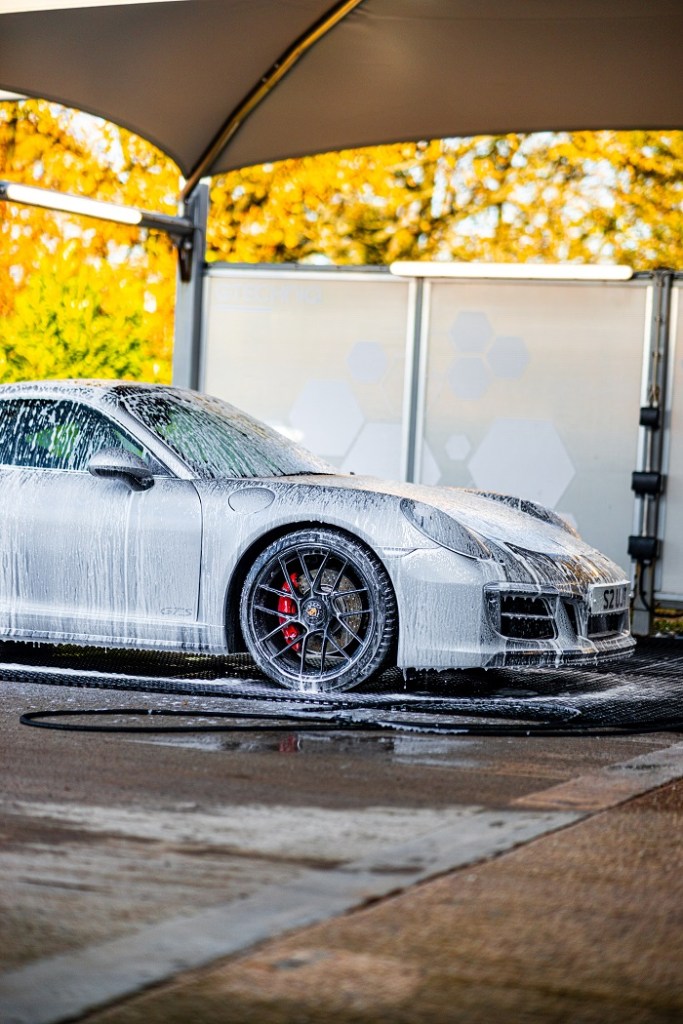
How to detail a car – which areas should I be cleaning?
Detailing a car is a skill. Doing it right, and in the correct order, not only means that your car is shining all year round, but it’ll also combat things like rust build up and paintwork damage. Besides, who wants to get into your car as a passenger if you’ve got dirty handles and snack packets in the footwell?
You don’t have to used a detailing service to get professional results either. Following these steps below, you’ll learn how to detail a car correctly at home.
Detailing wheels and tires
How long: 5-20 mins.
Products: Wheel cleaner.
Detailing gear: Bucket, grit guard, wheel brushes, tire brush.
Wheels and tires are the first things you should tackle when car detailing. This is because they tend to be the dirtiest areas. You don’t want to wash them after you’ve detailed the rest of your car. If you’re in a rush and your wheels aren’t too bad, you can get away with just spraying the wheel cleaner on and letting it dwell before rinsing it off, otherwise, you’ll want to use some wheel brushes to give the surfaces a thorough clean. A tire brush will help get your rubber clean and make sure you use a separate bucket with water to rinse off your brushes as you go.
Check out our step-by-step guide on how to clean your alloy wheels so you can perfect the process. You can also check out the best alloy wheel cleaners on the market right now.
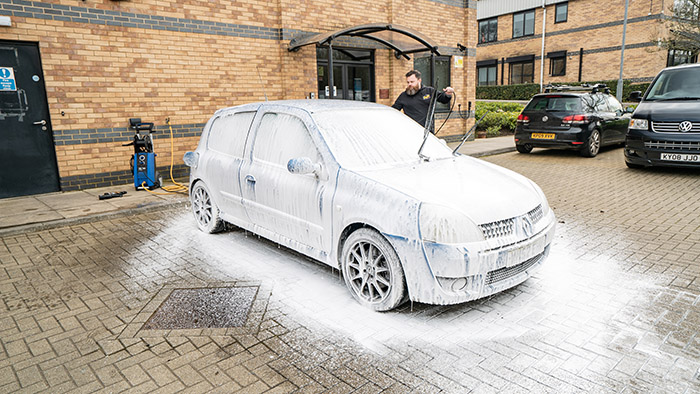
Pre-washing a car / decontamination stage
How long: 10-30 mins.
Products: Pre-wash spray, snow foam.
Detailing gear: Soft detailing brushes, foam cannon.
When we think about what is car detailing, we immediately think about washing the car. But prepping the surface before using shampoo is essential for the ultimate shine. Done correctly, the pre-wash stage of car detailing will remove enough dirt to make the actual washing stage a breeze. A good pre-wash spray, like an MPC or citrus product, should be applied to the dirtiest areas of the car, like the lower portions of the panels, and allowed to dwell before you apply the snow foam. While this dwells, use your soft detailing brush on the window rubbers and badges before rinsing everything off.
If your car isn’t too dirty, and you’re short on time, go straight in with the snow foam. You’ll still get good results.
Check out our step-by-step guide on how to pre-wash your car so you can perfect the process. Looking for the best products? Check out our guide to the best snow foam.
Washing a car
How long: 20-40 mins.
Products: Shampoo.
Detailing gear: Wash mitts, two buckets, grit guards.
The detailing essentials here are your two buckets, both equipped with grit guards, and one or more microfiber wash mitts. Having two buckets helps to keep your wash water cleaner. The grit guards help to keep heavier particles at the bottom of the buckets. This prevents them from getting onto your wash mitt and potentially causing damage. Wash mitts, ideally microfiber ones, effectively lift dirt away and trap it, so it won’t scratch your paint while you wash.
Always wash from the top (the cleanest area on the car) to the bottom (the dirtiest); you can even use a dedicated wash mitt on the lower areas and another for your exhaust tips.
Check out our step-by-step guide on how to wash your car so you can perfect the process. Looking for the best products? Check out our guide to the best car shampoos.
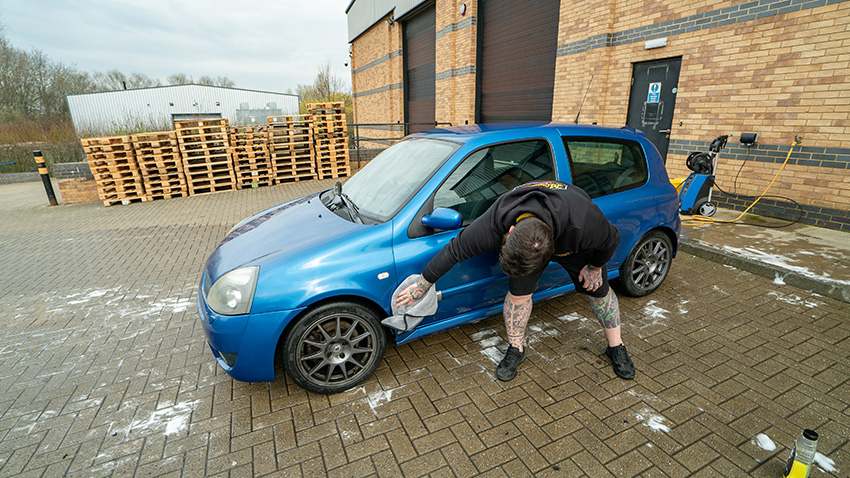
Drying a car
How long: 10-30 mins.
Detailing gear: Drying towels.
The key to drying your car thoroughly, is using the biggest, most absorbent drying towel you can find. This will make your job so much easier. One of these will suck up the water far more effectively than other types of towels and cloths. This will leave you with fewer streaks and water spots. Again, it’s always best to dry from the top down. It’s also a good idea to have a spare towel to hand in case your first starts getting waterlogged and stops drying as well as it should.
Check out our step-by-step guide on how to dry your car so you can perfect the process. Looking for the best products? Check out our guide to the best car drying towel.
Applying tire shine
How long: 5-10 mins.
Products: Tire dressing.
Detailing gear: Applicator, cloths.
Applying tire shine doesn’t just leave your tires looking lovely and black. It also helps to keep your sidewalls looking cleaner for longer and protects the rubber from UV damage. It doesn’t take long to do and is always worthwhile. The quickest and simplest products to use are aerosols that you simply spray on and leave. Gels need to be applied directly to the tire by hand. If you’re not a fan of high-shine finishes, don’t worry, most tire dressing products can be applied in a way that will leave you with either a glossy or matt finish.
Check out our step-by-step guide on how to apply tire shine so you can perfect the process. Looking for the best products? Check out our guide to the best tire dressings.
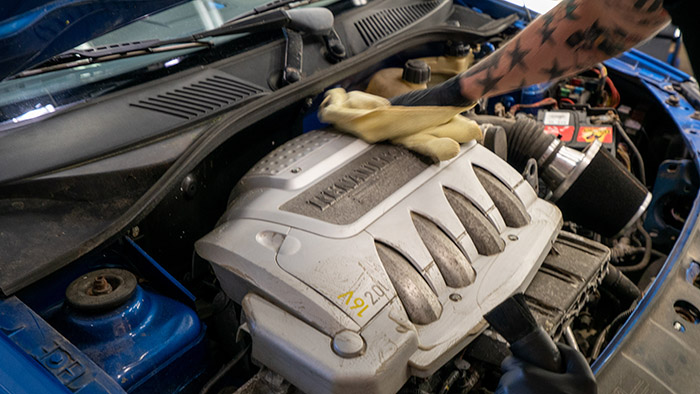
Detailing a car’s engine bay
How long: 20 mins+.
Products: Multi-purpose cleaner.
Detailing gear: Detailing brushes, microfiber cloths.
The engine bay is one area of any car that very few people think about cleaning. However, it can get pretty mucky under the bonnet, so it’s worth keeping on top of alongside your car detail. You can go pretty full-on, opting for steam cleaning or even snow-foaming your engine. But, the simplest and safest way to keep your bay clean is with some MPC and some detailing brushes. This will allow you to shift grease and grime, instantly getting your engine bay looking that much cleaner and shinier with minimum effort.
Check out our step-by-step guide on how to clean your engine bay so you can perfect the process.
Using a clay bar on a car
How long: 2 hours+.
Products: Clay bar, quick detailer.
Detailing gear: Microfiber cloths.
What is car detailing without a little elbow grease? Claying your car isn’t something you’ll be doing often. It should, ideally, always be followed up with paint correction, as the process can mar the surface of your car’s bodywork. Clay is incredibly sticky and will lift dirt and contaminants that have adhered to your paintwork, which washing alone won’t remove. You’ll be amazed at just how much dirt claying will remove, especially on a car that’s never been clayed before, and it will leave the surface of your paint incredibly smooth to the touch.
Take your time, don’t rush, and do each section carefully and thoroughly. If you are in a hurry, you can use clay mitts and cloths, many of which only need to be used with shampoo rather than quick detailer, and these will deliver good results but can be a little aggressive, meaning clay bars are still the best choice.
Check out our step-by-step guide on how to use a clay bar on your car so you can perfect the process.
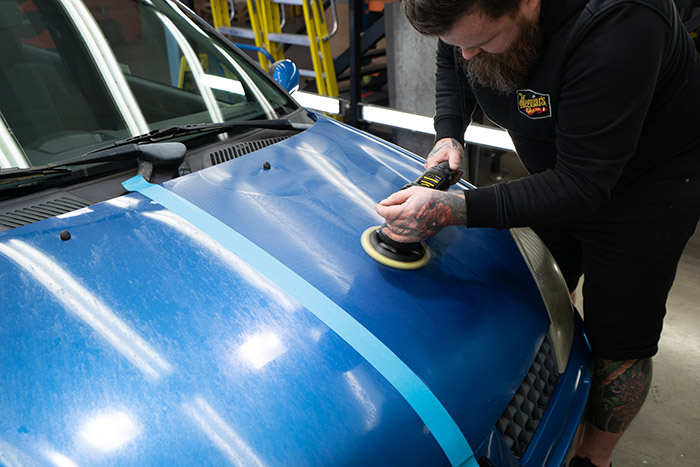
Polishing and paint correction car detailing
How long: 3 hours+.
Products: Correction compound, polish.
Detailing gear: Dual-action polisher, cutting pads/discs, polishing pads/discs, paint-depth gauge.
Paint correction might seem intimidating, but done correctly and with care, you can get exceptional results. It’s not a step you should be skipping if you want the ultimate car detail. This process involves using a cutting compound to remove the microscopic layers of lacquer that have swirls and imperfections in. This leaves your paint looking incredibly shiny, with stunning depth and crystal-clear reflections. A dual-action polisher makes the job that much easier, and the action of the head means that it’s very safe to use, making it almost impossible to damage the paint.
If you’re serious about the job, you can use a paint-depth gauge to make sure your paint isn’t too thin.
The general rule of thumb is to always start with the least aggressive compound on the softest pad, which will give you an idea of whether you need to go to a more aggressive combination if you’re not getting good results initially. You’ll be working your way across your car’s bodywork, section by section. You never want to try to correct too large a portion at once; it’s always better to work in smaller, more manageable sections and always take your time.
If your paint is bad, it might need multiple passes to remove the worst of the swirls. Once you’re done with correcting the paint, polishing will help to refine the finish, leaving you with stunning paintwork.
Check out our guide to paint correction for more advice. Looking for the best products? Check out our guide to the best car polishes.
Waxing a car
How long: 20 mins+.
Products: Paste/liquid/spray wax.
Detailing gear: Applicator, microfiber cloths.
Waxing your car will enhance the gloss and shine of your paintwork, as well as helping to protect it and keep it cleaner for longer. Paste wax is the more traditional choice, but it requires a bit more work as you have to spread it over the whole car by hand, let it cure and then buff it off, so it’s a bit of a workout. Burning a few extra calories while you’re detailing your car isn’t such a bad thing now, is it?
Liquid waxes are much quicker to apply, and you will often find the same version of paste waxes in liquid form. While you still have to apply the wax by hand, applying a liquid is obviously much quicker and easier than a paste. Finally, spray waxes are ideal for those who want the gloss and shine, but without taking all that time and effort, and these days you don’t have to compromise as the latest spray waxes offer incredible durability and protection.
Remember to always wax out of direct sunlight, go section by section, and have a handful of microfiber cloths to hand to make removal and buffing easier.
Check out our step-by-step guide on how to wax a car so you can perfect the process. Looking for the best products? Check out our guide to the best car waxes.
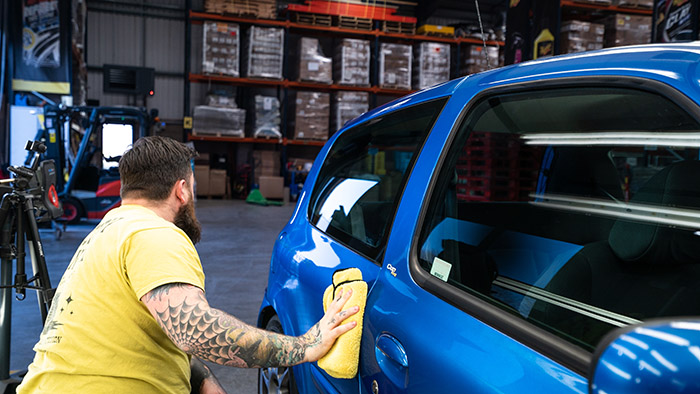
Maintenance car detailing
How long: 30 mins+.
Products: Quick detailer.
Detailing gear: Microfiber cloths.
Attempting to detail your car’s paintwork between washes might sound like a terrible idea, but as long as your car isn’t too dirty and it’s done carefully, you can get your car’s paint looking lovely with just a little effort. The key is to be gentle and take your time, using liberal sprays of quick detailer to lubricate the bodywork, then gently wiping with the microfiber cloth to lift the dust and dirt away. It’s the perfect way to keep your car clean in between washes while also adding an extra layer of protection via the quick detailer.
Be sure to check out our guide on how to maintenance wash a car.
Interior car cleaning
How long: 20mins+.
Products: Interior cleaner, carpet cleaner, leather cleaner.
Detailing gear: Detailing brushes, carpet and upholstery brush, microfiber cloths, vacuum cleaner.
The state of your interior will naturally dictate how long it will take to clean, but the good thing is that you can obviously do as much or as little as you need and as you have time to do. While vacuuming your carpets is a given, it’s also a good idea to vacuum in the creases of your seats to get all those little bits of dirt that are stuck in there. Cleaning your leather seats is one thing, but never underestimate just how dirty your leather steering wheel gets.
Some leather cleaner, a brush and a microfiber cloth will remove so much grime and leave your wheel looking and feeling much nicer. Don’t forget your door and dash trims, too, and some time with a detailing brush and interior cleaner will shift dirt you can’t even see and get your interior feeling so much fresher and nicer.
Check out our detailed guide on how to clean your car’s interior for more advice. Looking for the best products? Check out our guide to the best interior detailer.
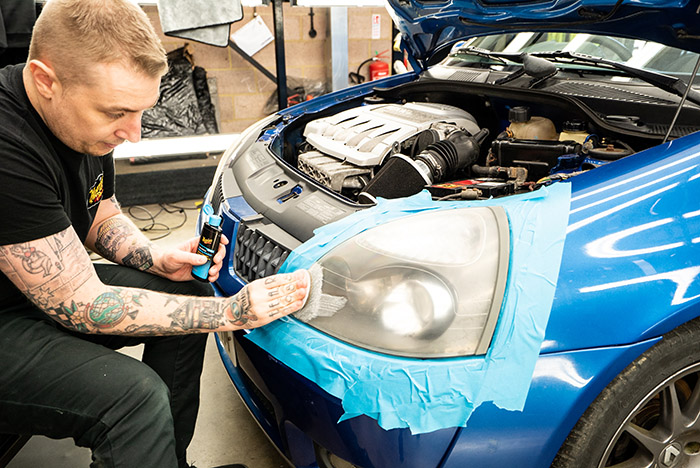
Headlight restoration
How long: 20 mins+.
Products: Headlight lens restoration kit.
Detailing gear: Drill.
Ugly, faded, cloudy yellow plastic headlight lenses not only look ugly, but they also reduce light output, so restoring them is well worth the effort. The easiest way to do this is using a kit that includes everything you need – some will come with a drill attachment that makes polishing off the yellow layer that much easier, while others are designed for hand application. The key is to apply a protective coating after polishing, as otherwise, UV damage will cause them to turn yellow again, so look for a kit that already includes that and never skip that step.
Check out our step-by-step guide on how to clean car headlights. Looking for the best products? Check out our guide to the best headlight restoration kit.
Car glass cleaning
How long: 10 mins+.
Products: Glass cleaner.
Detailing gear: Microfiber cloths.
Washing your car will clean the glass, naturally, but it won’t be as clean as when you do it yourself properly and don’t forget about the inside of your glass, too. Depending on how dirty your glass is and how deep a clean you want to administer, you can go so far as claying your glass to remove contaminants that are really bonded onto the surface. You can also use glass polish, which will also help to deliver a deeper clean than just glass cleaner on its own. And, once you’re done with the glass on the outside, make sure you take the time to clean the inside as well, as it gets dirty too and will impair your vision.
For more advice, check out our step-by-step guide on how to clean car windows. Looking for the best products? Check out our guide to the best car glass cleaner.
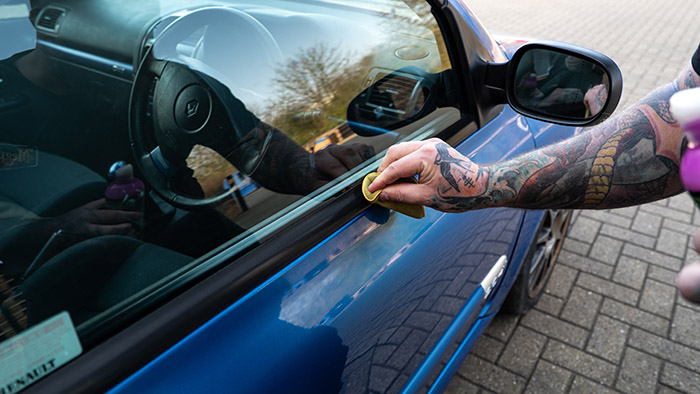
Car trim restorer
How long: 15 mins+.
Products: Trim restorer.
Detailing gear: Applicator pad.
Faded black plastic trim looks awful, turning grey or white over time, and it can really ruin the appearance of your car. Luckily, restoring it to its former glory is quick and easy, and all you need is some trim restorer and an applicator, and you are good to go. Which is why we’ve mentioned here in our what is car detailing guide. It won’t be permanent, but it’s so easy to do that it’s no big deal to re-do it whenever your trim starts fading again.
Check out our guide on how to restore black trim on a car for more advice.
Metal polish
How long: 10 mins+.
Products: Metal polish.
Detailing gear: Microfiber cloths.
Getting the perfect finish on the metal elements on your car adds that final touch. All you need is your metal polish of choice and some microfiber cloths, plus a little elbow grease, and not only will you get those metal surfaces looking instantly better, but you’ll also help them to stay shinier and cleaner for longer.
Check out our guide on how to polish metal on a car for more advice.
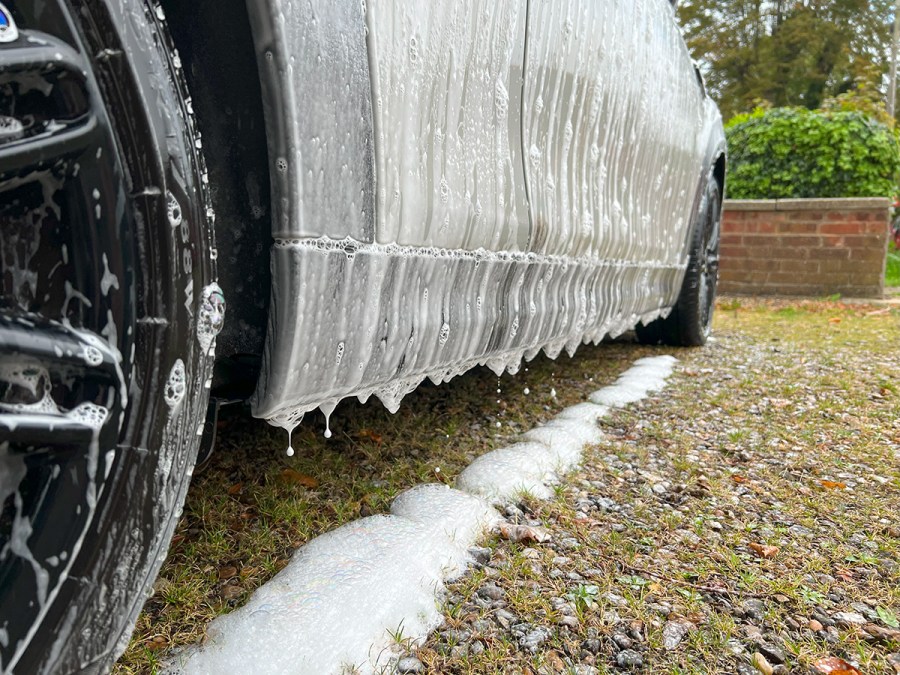
DIY car detailing vs hiring a professional detailer
Depending on the condition of your vehicle, if you’re keen to put the time in, you can get some fantastic results detailing your car at home. This is especially true if you’ve got your hands on the right products and equipment to get the job done. This means you’ll want products for each area of the car listed above, as well as things like microfiber cloths, two buckets, wash mitt, wheel brush, a drying towel and applicators for your wax/polish. This is the minimum if you want to do a good job at home, which means there are some initial costs. To take it to the next level, you’ll need a machine buffer for applying polish.
With that in mind, it all depends on the condition of your vehicle. If it’s relatively new, or has been maintained well over the years, then you should be able to deliver all you need from home. However, for cars that require more paint correction, hiring a detailing professional can bring your car up to showroom condition. That level of service doesn’t come cheap, however. The very basic detailing services will costs around $/£50, but this figure can quite easily climb to over $/£500 depending on the condition of the vehicle and the time taken for paint correction. This would usually be called restorative car detailing at this stage, as this is reserved for the very worst condition cars.
Remember, though, professional car detailers are not magicians, so you’ve got significant bodywork damage, no amount of polish will buff that out.
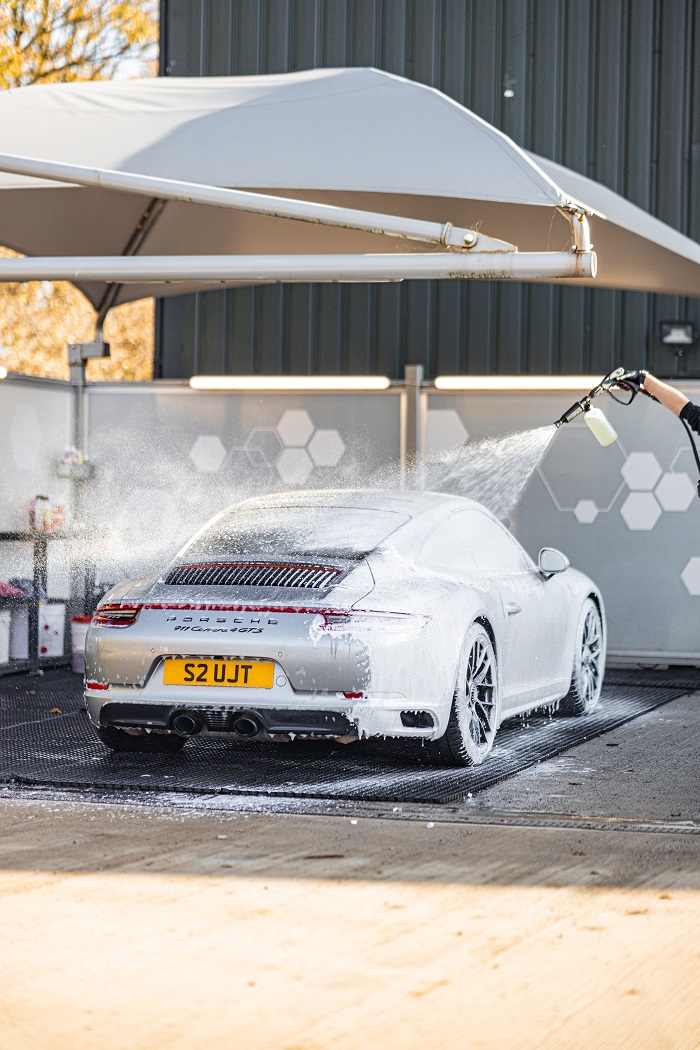
Automated car washes vs. washing your car at home
Now, before we properly get started, you might be wondering why we don’t suggest just using one of those automated car washes you see at the gas station. After all, the take the hassle out of the job, right?
True. But at what cost? Truth be told, if you want to clean your car well, a automated car wash is NOT the way to do it. There’s a ton of reasons for this. Firstly, those big spinning cloths that envelope the car as it passes through the automated tunnel aren’t exactly the gentlest of devices. As such, they’ll typically leave your car with swirl marks, and potentially paint chips too. Heck, we’ve even heard horror stories about those brutish spinners ripping of antennas or damaging bodywork trim. Though admittedly, modern automated car washes pose less of a risk of such dramatic results than they did when the technology was new.
Nowadays, there are also some automated car washes which use touchless water jets. This eradicates the potential harm caused by a massive spinning brush, but to make up for its potency, touchless car washes tend to utilize harsher chemicals in the shampoo that they use. As a one-off, or very infrequent solution, this is unlikely to do real damage. But, if you get lazy and repeatedly rely on these touchless systems in the long-term, don’t be surprised if you eventually notice your clear coat starting to peel away. On top of that, these facilities tend not to have drying equipment, which will leave you with a bunch of annoying water marks every time you detail your car.
Verdict
Ultimately, while an automated car wash may be tempting as a quick and easy solution, it’ll never be as thorough or gentle as a traditional hand wash at home. And trust us, even if you’re not a fan of manual labor, car detailing doesn’t have to be a nightmare.
Not only that, but automated car washes completely ignore your car’s interior. After all, you spend most of your time inside the car, so why shouldn’t that be detailed to as high a standard? Pick up your vacuum, some interior detailing spray and go to work with your microfiber cloth.
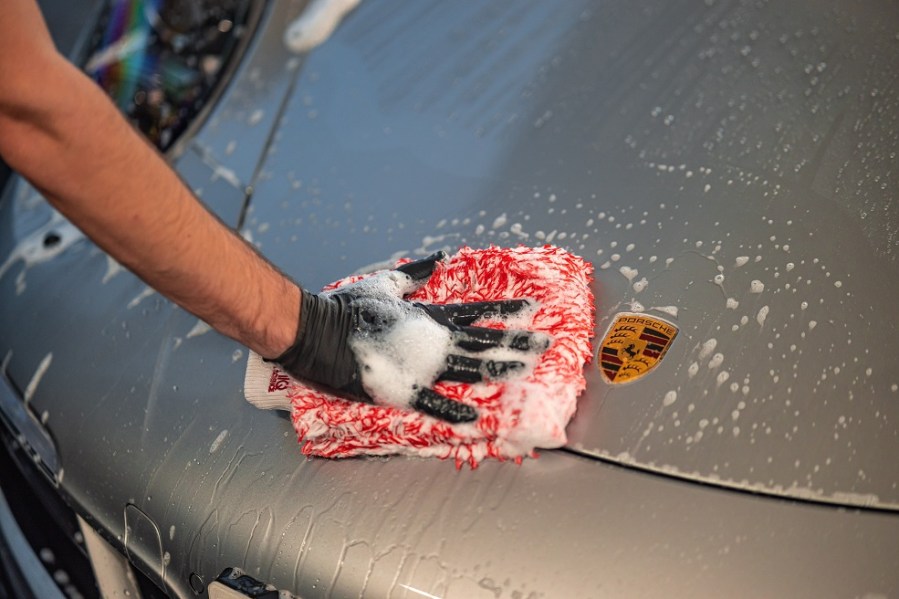
Car detailing FAQs answered!
We’ve already answered what is car detailing, but what else do people ask? Here, we’ll answer some of the most frequently asked questions when it comes to car detailing. Splitting myths from reality, and explaining why you need two buckets, not one.
Should you use two buckets or one bucket washing your car?
90-percent of swirl marks are inflicted during the washing process. Using two buckets allows you to have one bucket with the shampoo solution in and a separate rinse bucket with a grit guard at the bottom. This means the mitt is clean when it goes into solution and then on to the car, this drastically reduces the chance of swirl marks in the contact washing process.
What is clay barring? Isn’t this something best left to the professionals?
Claying is probably the best investment in time when it comes to preparing your car’s paintwork. Clay is basically a reset button for the upper surface of your paint. If your car feels rough to the touch after a wash, then clay is for you. It will remove all above-surface contaminants such as overspray, traffic film, wax, everything! Allowing you to assess the surface and then attack those swirls marks!
Apart from making your tires look like new, are there any other benefits to using tire shine?
This is always a hard topic as it’s personal preference. Some people don’t like them dressed, some like a high gloss finish and others are somewhere in the middle.
Can you use dish soap to wash your car?
No. Don’t do this. While it’s very good at removing food and grime from your dishes, it’s no good on your car. In fact, the same degreases eat away at any wax or sealant you have on the car, leaving your paintwork exposed to damage. Avoid the dish soap!
Can detailing your car too often damage the paintwork?
No. We’re not sure where this myth came from, but it’s certainly not true. In fact, the dirt and grime that builds up over the course of a week of driving is more damaging to your paintwork then cleaning it. This is provided you’re cleaning your car correctly, as incorrect methods can lead to paintwork damage such as swirl marks.
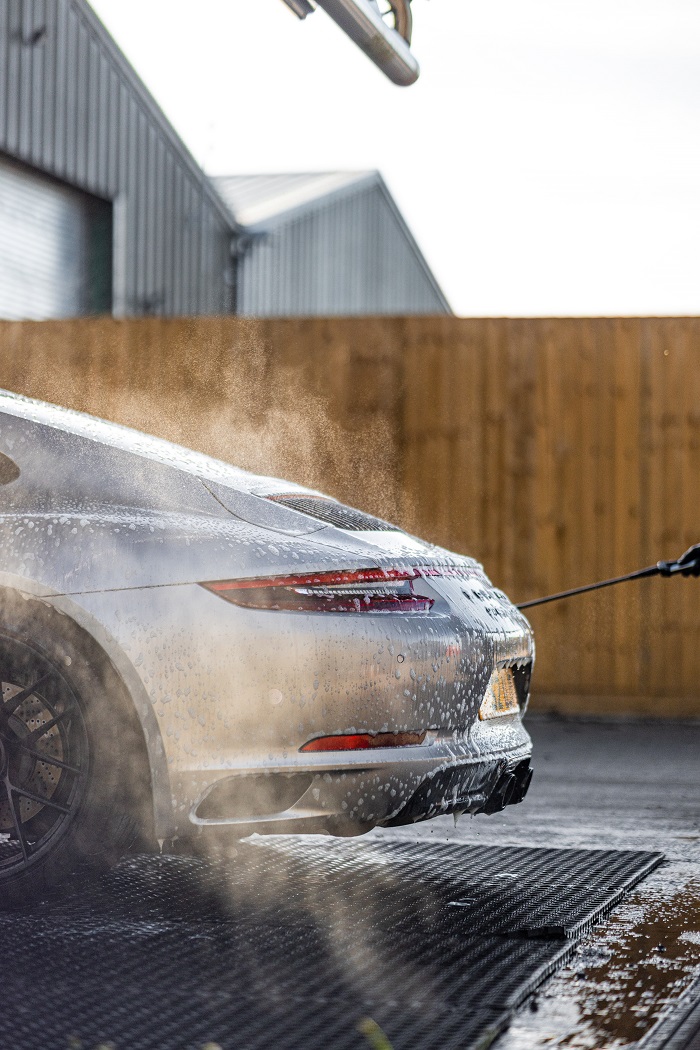
Is it worth investing in a pressure washer?
If you like an easy life, yeah, I would. Car cleaning isn’t much fun without one and they tend to use far less water than a normal hose anyway.
Click here to browse some of the best on the market.
Is 100 percent carnauba the best wax I can buy?
Despite some manufacturers’ claims, no car wax is 100 per cent carnauba. You wouldn’t be able to use it – carnauba is about as solid as concrete in its natural form. Most car wax products have a natural wax content, like carnauba, and the rest is a mixture of solvents and other additives that make it possible to apply and enhance its properties. Of course, you can have a product that only contains carnauba and no other type of natural wax, as well as all the other stuff, and clever marketing could say that’s ‘100 percent carnauba’. But the wax will never be 100 percent of the whole product.
Here’s a guide to the best car waxes in 2023.
Are spray-on tire dressings better than paint-on ones?
There are good tire dressings and there are not so good ones. Silicone solvent-based shines are more suited to brush or sponge application, because you don’t want them misting all over your paint. Water-based dressings are better to spray on because they won’t smear on paint and are more easily absorbed into the tire. The thing to look out for is something that’s high shearing. This means it actually gets thicker as your wheels spin, so it’s less likely to splatter all up the side of your car. Low shear tire shines get thinner, and that’s not ideal.
What’s the best way to care for my vehicle wrap?
Mainly regular washing. Unlike paint, vinyl wraps won’t benefit from abrasive polishes. I suppose technically you could wax a gloss wrap, but that would depend on the solvents and other ingredients used in your wax. You can use quick detailers on both gloss and matt wraps along with matt paint surfaces, but always read the label on your product and, if in any doubt, ask first.
Is there actually a real difference between wax and polish?
A huge difference. A polish is an abrasive. Not an aggressive abrasive like a compound, but abrasive enough to clean and refine paintwork. It’s a preparation product, whereas a wax is a protectant. No true wax is abrasive, it’s just there as a sacrificial layer to protect your paint… along with all the hard work and preparation you’ve put in.
We’ve done a full guide on the differences between wax polish right here.
How often should I wax my car?
A good quality wax or sealant should last up to three months, but you shouldn’t wait that long to clean your car. Personally I’d recommend cleaning and waxing or sealing once a month, to build up a good barrier to the elements. After three or four applications you’ll hit a nice plateau of protection.
For more advice, check out our full guide on how often should you wax a car.
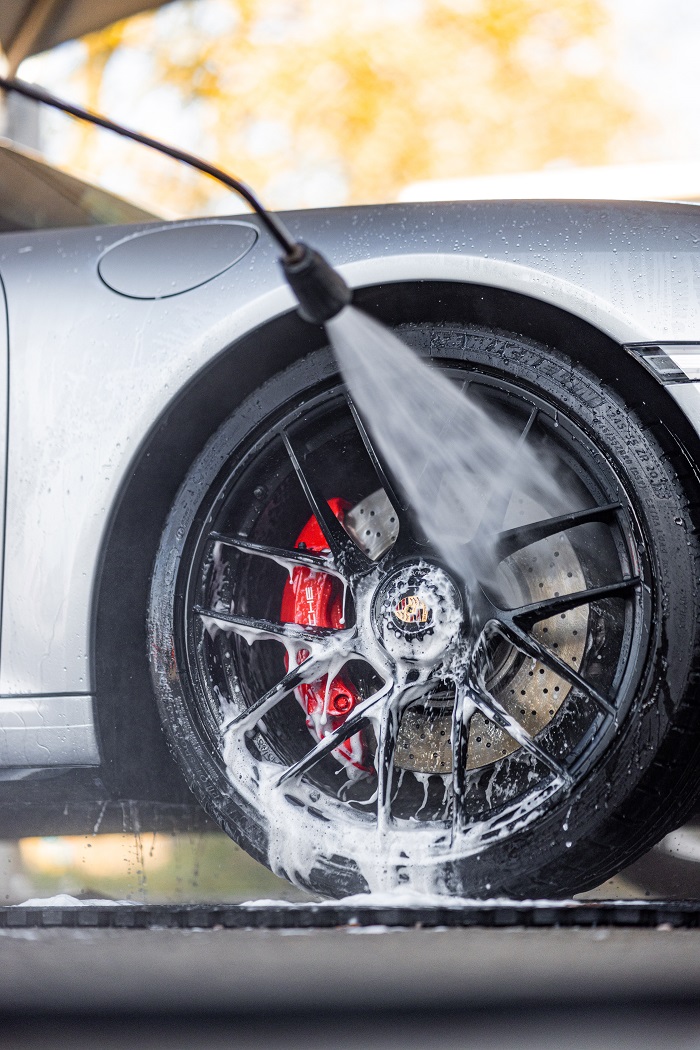
Do I need a special type of wheel cleaner for polished wheels?
It’s definitely important to check that your wheel cleaner is safe for your particular wheel finish. There are basically three types of wheel cleaner. Traditional acidic cleaners have plenty of power for melting away baked-on brake dust and can be used on the majority of painted and clear-coated rims. That said they are generally corrosive and not something you’d want to use all the time. Never use these on chrome, polished or other sensitive surfaces.
Check out our guide to the best alloy wheel cleaners.
What is an LSP in car detailing?
One of those annoying industry buzzwords. It means Last Stage Protection and refers to the waxes or sealants you apply in the last stage of car detailing. Your paint’s final barrier to the elements.
How do I use snow foam?
Snow foam is great stuff and can be used either through a foam lance on a pressure washer or even a cheap garden sprayer. The idea is that you spray the diluted foam all over your car, wait a few minutes while it breaks down and lifts off dirt, then rinse off, so you can go on with your sponge and shampoo. There’s two types to be aware of – alkaline and PH neutral snow foams. Alkaline foam is great for cleaning bug splats and fuel stains, but is pretty harsh and can damage wax or sealant layers. That’s why I’d only recommend those for professional use, or for the guys trying to get right back to the paint. PH neutral foams are a little milder and safer for continued use, like a nice dusting in the summer, and won’t strip waxes.
Check out our guide to using snow foam like a pro here.
What is a ‘non-stripping’ shampoo?
I suppose that means it claims it doesn’t strip wax or sealants. But then no shampoo should strip wax or sealants anyway. Technically speaking, every car shampoo should be ‘non-stripping’. But be sure you’re using the best, check out our guide to the best car shampoo.
What is a sealant?
A sealant is synthetic material developed to protect your paint, basically a man-made version of a wax. Waxes are a natural product, whereas a sealant will be a mixture of manufactured fortified polymers. Some prefer using sealants to waxes, some prefer waxes and some like to use both. As to which are best? It’s all down to personal preference. Neither is going to hurt.
How do I use an electric polisher?
They can be a minefield especially in the DIY market. If you must use one at home firstly only use a very mild compound, not an aggressive one. Secondly look at the type of polisher. I wouldn’t recommend a rotary polisher. Many on the market spin way too fast and it’s far too easy to melt the paint and rip the pad off if you don’t keep it moving – I’ve done it myself! You don’t have the same problems with a DA (dual action) polisher as you’ve got much more control, but they can be very expensive for a good one. Polishers are very effective if you know what you’re doing, but don’t forget you’ve only got the lacquer layer to work with. If you’re down to the paint that’s way too far.
Should I use a chamois leather on my car?
It’s much better to dry your car with a clean microfiber cloth. Dragging a chamois over the surface of your paint isn’t always the best. Many are treated with oils that can leave a nasty smear that you’ll have to buff off. Microfiber cloths are cheap enough and much easier to clean. Just remember to chuck them in the washing machine when you’re done.




